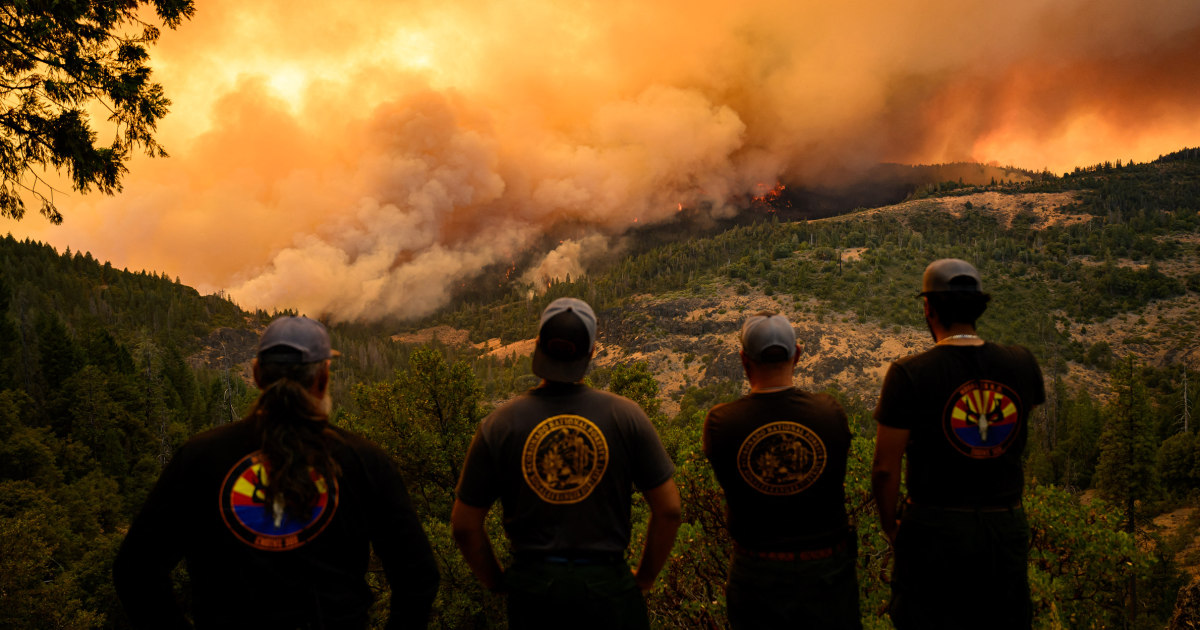About 10% to 15% of California’s wildfires are ignited by arson each year — and 2024 appears to be in line with the trend. But as climate change leads temperatures to rise, fire seasons to grow longer and drought conditions to become more intense, intentionally set fires have more opportunity to take off and grow.
That has led more than 477,000 acres to burn due to alleged acts of arson this year — by far the most since 2014, when 98,259 acres burned due to arson, according to Cal Fire.
Muschetto said arson-ignited fires pose the highest risk when drought or other consequences of climate change have led timber to dry out.
“Then it’s more likely that those fires have the opportunity to get larger quicker, and to damage or burn homes — or hopefully not, but possibly — injure or kill folks that are unable to escape because that fire ends up growing,” he said.
What’s more, he added, wildfire season lasts longer in California than it used to. The state’s southeast desert basin has added 61 additional fire weather days from 1973 to 2022, according to the nonprofit group Climate Central.
“That just means more opportunity to light wildfires throughout the year,” Muschetto said.
This week, parts of California have been withering in a record-setting October heat wave. Temperatures in the Los Angeles area were expected to become “dangerously hot” away from the coast, with temperatures reaching 105 degrees in some regions on Saturday, according to the National Weather Service.
Jeffrey Prestemon, a researcher at the U.S. Forest Service’s Southern Research Station in North Carolina, said arson also presents an acute risk because fires started that way tend to cause more damage per acre than blazes caused by lightning or other factors.
“They’re often set where … people live, where there are structures,” Prestemon said.
Given that, he said, “an arrest can have a big payoff.”
Prestemon has studied wildfire arson events in Florida, Spain and other locations. He and other researchers found in one study that the arrest of a single arsonist in a particular region of Spain correlated with a decrease of nearly 140 wildfire starts in that area the following year.
“What we surmise: It’s mainly a serial effect, it’s one individual setting multiple fires over a brief period of time usually spanning over several days, a week or two weeks,” Prestemon said. “If they’re not caught, they will repeat this kind of serial episode.”
Prestemon added that arrests could deter other arsonists.
This year in California, Cal Fire had arrested 91 people on suspicion of arson by the end of August, Muschetto said. The number appears to track with normal trends.
Wildfire arson isn’t well studied, but researchers in the U.S., Europe and Australia have narrowed down the profile of typical perpetrators. Wildfire arsonists tend to be men, often young. Many set multiple fires.
“They’re often likely to do repeat fires,” said Janet Stanley, an honorary associate professor at the University of Melbourne in Australia. “People who have got a psychological need for some reason around fire will do it many times, and often they’re not caught until they’ve done it multiple times.”
In California, Muschetto attributed fluctuations in the number of wildfire arsons to fire risk levels and how likely the landscape is to burn.
Cal Fire has counted between 182 and 386 arson fires each year since 2014, with rates roughly consistent relative to the number of overall fires. However, the true number of fires caused by arson is likely higher than the official count, because investigators can’t always determine how a blaze started. The causes of more than 320 fires in 2023 remain unknown.
For similar reasons, wildfire arsons can also be difficult to prosecute, experts said. In comparison to urban arson, these crimes often produce less physical evidence, said Daniel Fox, a prosecutor in the Riverside County District Attorney’s Office who has handled wildfire arson cases.
“It takes so much less to get the fire going and have it become monstrous when you’re talking about wildland, versus if I want to burn a car or the side of somebody’s house,” Fox said.
That’s particularly true in rural parts of his county, Fox added, where the landscape is so dry that he joked even a sideways look at the grass is “liable to turn into flames.”
Muschetto said Cal Fire investigators are trained to identify wildland fire patterns and where a fire originated, then search for any remnants of an ignition source.
“It could be something as small as a match head that’s all that’s left. You might find nothing if it’s completely consumed up in a fire,” Muschetto said.
That can leave investigators reliant on witness reports and circumstantial evidence. Muschetto said the rise in the use of security cameras, smartphones and satellite-tracking devices in rural areas has helped Cal Fire clear more cases over the past 10 or 20 years.
Still, even when cases go well for prosecutors, victims of arson-ignited wildfires rarely end up whole, Fox said.
He led the prosecution of Brandon McGlover, who ignited several fires that led to the 2018 Cranston Fire, which burned more than 13,000 acres near Idyllwild, California, and destroyed several homes.
Investigators were able to link McGlover’s plausible movements that day to several fires, Fox said. They had eyewitness testimony connecting McGlover’s car to an area where a fire started, video from traffic cameras, security video and cans of WD-40 discovered in his car.
The prosecutors reached a plea deal, and McGlover was sentenced to more than 12 years in prison and ordered to pay restitution to the victims. But Fox said the people who lost property are unlikely to get their full losses covered through insurance or restitution.
“The reality is, there’s no real mechanism to compensate them,” Fox said. “His name wasn’t Bezos or Rockefeller and he was going to prison for a long period of time.”
Stout, the Park Fire suspect, was arrested on July 25, one day after the blaze started, and charged with “arson of an inhabited structure or property.” If convicted, he faces 25 years to life in state prison.
Mike Ramsey, the Butte County district attorney, said in an email that Stout has said that the witness account of his alleged actions is incorrect.
Stout is being held in Butte County Jail while awaiting trial. His next court appearance is Oct. 17, when a date is expected to be set for a preliminary hearing.






